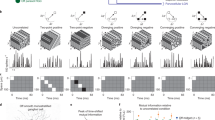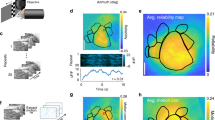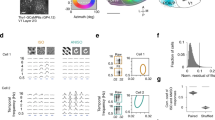Abstract
Moving objects can cover large distances while they are processed by the eye, usually resulting in a spatially lagged retinal response. We identified a network of electrically coupled motion–coding neurons in mouse retina that act collectively to register the leading edges of moving objects at a nearly constant spatial location, regardless of their velocity. These results reveal a previously unknown neurophysiological substrate for lag normalization in the visual system.
This is a preview of subscription content, access via your institution
Access options
Subscribe to this journal
Receive 12 print issues and online access
$209.00 per year
only $17.42 per issue
Buy this article
- Purchase on Springer Link
- Instant access to full article PDF
Prices may be subject to local taxes which are calculated during checkout



Similar content being viewed by others
References
Barlow, H.B., Hill, R.M. & Levick, W.R. J. Physiol. (Lond.) 173, 377–407 (1964).
Vaney, D.I., Sivyer, B. & Taylor, W.R. Nat. Rev. Neurosci. 13, 194–208 (2012).
Gollisch, T. & Meister, M. Science 319, 1108–1111 (2008).
Oyster, C.W. J. Physiol. (Lond.) 199, 613–635 (1968).
Vaney, D.I. J. Neurosci. 14, 6301–6316 (1994).
Trenholm, S., Johnson, K., Li, X., Smith, R.G. & Awatramani, G.B. Neuron 71, 683–694 (2011).
Yang, G. & Masland, R.H. J. Neurosci. 14, 5267–5280 (1994).
Wassle, H., Puller, C., Muller, F. & Haverkamp, S. J. Neurosci. 29, 106–117 (2009).
Vervaeke, K., Lorincz, A., Nusser, Z. & Silver, R.A. Science 335, 1624–1628 (2012).
Berry, M.J. II, Brivanlou, I.H., Jordan, T.A. & Meister, M. Nature 398, 334–338 (1999).
Krekelberg, B. & Lappe, M. Trends Neurosci. 24, 335–339 (2001).
Nijhawan, R. Nature 370, 256–257 (1994).
Nijhawan, R. Trends Cogn. Sci. 6, 387 (2002).
Anderson, C.H. & Van Essen, D.C. Proc. Natl. Acad. Sci. USA 84, 6297–6301 (1987).
Oesch, N., Euler, T. & Taylor, W.R. Neuron 47, 739–750 (2005).
Shapley, R.M. & Victor, J.D. J. Physiol. (Lond.) 285, 275–298 (1978).
Völgyi, B., Chheda, S. & Bloomfield, S.A. J. Comp. Neurol. 512, 664–687 (2009).
Bloomfield, S.A. & Volgyi, B. Nat. Rev. Neurosci. 10, 495–506 (2009).
Hu, E.H., Pan, F., Volgyi, B. & Bloomfield, S.A. J. Physiol. 588, 4145–4163 (2010).
Acknowledgements
We thank W.H. Baldridge, B. Chow and K.R. Delaney for comments, K. Johnson for writing routines in Matlab and Z. Shi for maintaining mouse colonies. This work was supported in part by US National Science Foundation PHY-1058202 and EF-0928048 (V.B.) and was completed at the Aspen Center for Physics, which is supported by National Science Foundation PHY-1066293. This work was also supported by Canadian Institutes of Health Research 342202-2007 and Foundation for Fighting Blindness (Canada) (G.B.A.).
Author information
Authors and Affiliations
Contributions
All experiments were performed and analyzed by S.T. and were designed by S.T. and G.B.A. The computational model was developed by D.J.S., V.B. and G.B.A. The paper was written by S.T., V.B. and G.B.A.
Corresponding author
Ethics declarations
Competing interests
The authors declare no competing financial interests.
Supplementary information
Supplementary Text and Figures
Supplementary Figures 1–4 (PDF 314 kb)
Rights and permissions
About this article
Cite this article
Trenholm, S., Schwab, D., Balasubramanian, V. et al. Lag normalization in an electrically coupled neural network. Nat Neurosci 16, 154–156 (2013). https://doi.org/10.1038/nn.3308
Received:
Accepted:
Published:
Issue Date:
DOI: https://doi.org/10.1038/nn.3308
This article is cited by
-
Classical center-surround receptive fields facilitate novel object detection in retinal bipolar cells
Nature Communications (2022)
-
On the potential role of lateral connectivity in retinal anticipation
The Journal of Mathematical Neuroscience (2021)
-
An offset ON–OFF receptive field is created by gap junctions between distinct types of retinal ganglion cells
Nature Neuroscience (2021)
-
Multiplexed computations in retinal ganglion cells of a single type
Nature Communications (2017)
-
Electrical synapses convey orientation selectivity in the mouse retina
Nature Communications (2017)



